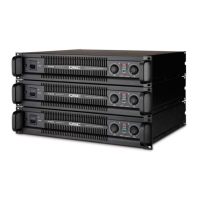34 QSC Audio Products, LLC
Figure 3.5 The power supply sync pulse.
Troubleshooting switch-mode supply control circuit
problems
Troubleshooting the power supply control circuitry requires that the
service fixture be connected to the amplifier.
Excessive current draw from the service fixture: The current
draw should be about 800 mA positive and 500 mA negative with all
the gate drives operating (measure using the service fixture’s
current monitoring feature). The current draw should be approxi-
mately +620 mA and -380 mA when the amp is muted (no gate
drive).
• Abnormally high current draw often indicates a short-circuited
gate drive or a short on the output of one of the linear regulators,
which will get very hot and current limit. When investigating
possible short circuits, look for solder shorts or bad ICs.
• Solder shorts on the 5 V regulators will typically overload the
12 V or 15 V regulators feeding them.
Abnormally low current draw: This usually indicates some major
switching subsection, such as a gate driver, is not working. If none
of the switching subsections are working, check for clock problems.
Clock problems: If the clock is not working, there will be no drive
to the power supply IGBTs or the audio output FETs.
• Check logic circuitry (schematic: see sheet AMP CH-A, zone C-7).
Crystal Y1 should oscillate at 16 MHz, and you should be able to
trace the 1 MHz signal from U1 pin 7 to where it is divided to
500 kHz and 250 kHz in U4.
• The square waves in Figure 3.4 show what the clock drive logic
signals should look like on pins 2 and 5 of U4. The signals’
frequency and voltage are 250 kHz and 0 to 5 V.
• Components C15, R26, and R21 create a short pulse buffered by
U5:1, which serves as the power supply sync signal. Note that it
is the same 250 kHz frequency as the clock drive signal but
comprises short positive pulses. See Figure 3.5.
• With the AC shut off and the amplifier powered by the service
fixture, check the drive signal at the gate of each of the two
IGBTs. See Figure 3.1. They should appear as somewhat
rounded square waves from gate driver transformer T4
(schematic: see sheet
“Power Supply, PL380”
zone D-3),
measuring about ±14 V peak. Each waveform should have a
slight but visible flattening as it crosses zero, which forms a
short dead time where both IGBTs are off (an IGBT turns on at a
V
GS
of about 7 V).
• The sources of the drive signals are on the primary side of
transformer T4. Trace T4 input back to U46 (schematic: see zone
D-2), which may be damaged after an IGBT breakdown. Verify
that the +15 V supply is present and so are drive signals from
U49, which should be synchronized to the 250 kHz pulse from the
SYNC line (see Clock, above). Check and if necessary, confirm
the values of, C275 and C277 (HF soft start time constant), Q70,
R297, R298 (reduces dead time), Q71, C276, D102, R300, and
R299 (resets C275, and also holds Q71 off if the TOP-SW supply
is not running).
NOTE: In normal operation, D102 and R299 couple negative
TOP-SW pulses into C276, turning off Q71 and enabling U49 to
ramp up to normal operation. The service fixture simulates the
effect of these pulses by pulling the base of Q71 to -0.6 V.
• DC Fault problems. If either channel develops a large DC
offset, the power supply is shut down to prevent load damage.
Sheet PROT/CNTRL, zone A-5, shows the DC shutdown system.
Each channel’s output is integrated via RC networks: R139 with
C105 (channel 2) and R140 with C106 (channel 1). Excessive
long-term positive or negative output voltages are rectified by
signal network D29, D30. D32 and Q40, Q42, Q46, and D33,
pulling down on AC-OFF-LO which discharges C104 (zone C-6),
thus shutting down the power supply. This behavior is also likely
if a low-voltage audio stage generates DC due to component
fault, being shorted to a rail, etc.
Power FET control circuit problems
The service fixture supplies operating power for all four FET gate
drive circuits, which can be inspected with the main supply voltage
shut off. CAUTION: Voltage—even residual amounts—on the main
supply rails can cause high current surges into a grounded scope
probe when it is connected to the FET sources. To avoid this, use
only isolated scope probes to look at gate drive signals when the
main power supply is operating.
With the FETs in place, AC power shut off, and the service fixture
supplying power, the drive signal at the gates (referenced to the
source) on each channel should be two similar but complementary
3.1 PL380: Symptoms, causes, and remedies (continued)

